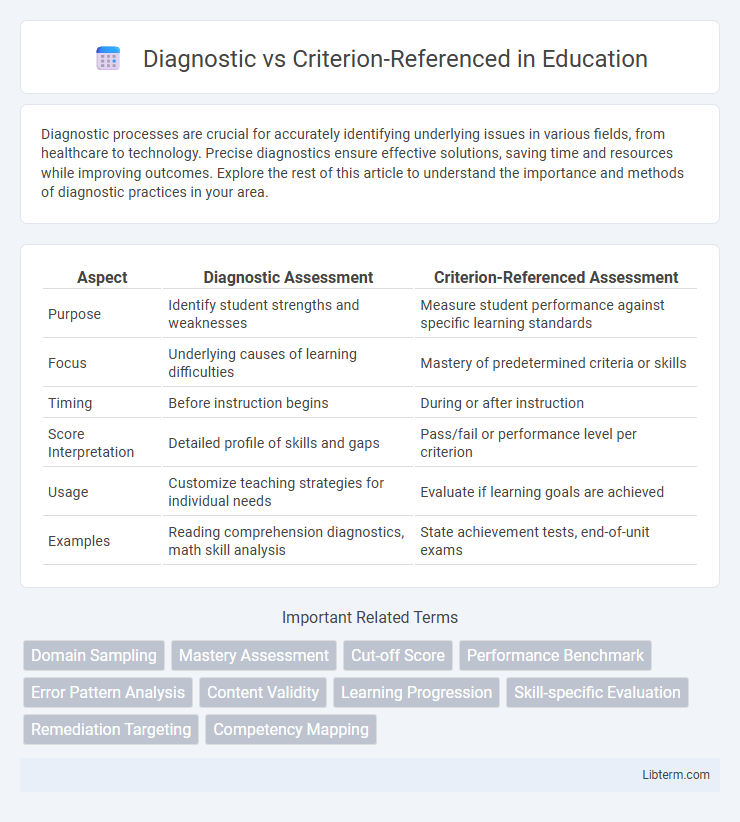Diagnostic processes are crucial for accurately identifying underlying issues in various fields, from healthcare to technology. Precise diagnostics ensure effective solutions, saving time and resources while improving outcomes. Explore the rest of this article to understand the importance and methods of diagnostic practices in your area.
Table of Comparison
| Aspect | Diagnostic Assessment | Criterion-Referenced Assessment |
|---|---|---|
| Purpose | Identify student strengths and weaknesses | Measure student performance against specific learning standards |
| Focus | Underlying causes of learning difficulties | Mastery of predetermined criteria or skills |
| Timing | Before instruction begins | During or after instruction |
| Score Interpretation | Detailed profile of skills and gaps | Pass/fail or performance level per criterion |
| Usage | Customize teaching strategies for individual needs | Evaluate if learning goals are achieved |
| Examples | Reading comprehension diagnostics, math skill analysis | State achievement tests, end-of-unit exams |
Introduction to Diagnostic and Criterion-Referenced Assessments
Diagnostic assessments identify specific student strengths and weaknesses to inform targeted instruction, often used before or during learning to address knowledge gaps. Criterion-referenced assessments measure student performance against predefined standards or learning objectives, determining whether specific skills or competencies have been mastered. Both assessment types guide educational decisions but serve distinct purposes: diagnostic assessments help personalize learning paths, while criterion-referenced assessments evaluate achievement relative to established criteria.
Defining Diagnostic Assessments
Diagnostic assessments identify specific strengths and weaknesses in a student's knowledge by analyzing detailed performance data against established learning standards. These assessments provide targeted feedback to guide instruction and intervention strategies, enhancing personalized learning plans. Unlike criterion-referenced assessments that measure mastery against fixed criteria, diagnostic assessments delve deeper into conceptual misunderstandings and skill gaps.
Understanding Criterion-Referenced Assessments
Criterion-referenced assessments measure a student's performance against a fixed set of criteria or learning standards, allowing educators to determine whether specific skills or knowledge have been mastered. Unlike diagnostic assessments that identify learning gaps and instructional needs, criterion-referenced tests provide clear insights into the level of proficiency achieved by comparing results to predetermined benchmarks. These assessments support targeted instruction by highlighting the extent of mastery on particular objectives rather than ranking students relative to peers.
Key Differences Between Diagnostic and Criterion-Referenced Tests
Diagnostic tests evaluate specific skill gaps by identifying individual strengths and weaknesses, often used to tailor instruction or interventions. Criterion-referenced tests measure performance against a predefined set of standards or learning objectives, determining whether a student has achieved mastery of particular content. Key differences include the purpose of assessment (skill diagnosis vs. mastery evaluation), scoring interpretation (detailed error analysis vs. pass/fail criteria), and application in educational settings.
Purposes and Applications in Education
Diagnostic assessments identify students' specific strengths and weaknesses to inform targeted instructional strategies, primarily used at the beginning of a learning period or unit. Criterion-referenced assessments measure student performance against predefined learning standards or criteria, enabling educators to determine mastery of specific skills or knowledge. Both assessment types guide differentiated instruction, with diagnostic tools supporting personalized intervention and criterion-referenced tests evaluating proficiency and curriculum effectiveness.
Benefits of Diagnostic Assessments
Diagnostic assessments provide detailed insights into a learner's strengths and weaknesses, enabling personalized instruction that targets specific skill gaps. These assessments help educators identify underlying learning challenges early, improving intervention strategies and academic outcomes. By offering actionable data, diagnostic tools enhance the effectiveness of teaching plans compared to criterion-referenced tests that mainly measure performance against set standards.
Advantages of Criterion-Referenced Assessments
Criterion-referenced assessments provide clear advantages by measuring student performance against specific learning standards, allowing for targeted identification of strengths and weaknesses. These assessments offer precise feedback that supports personalized instruction and mastery learning, enhancing educational outcomes. By focusing on predefined criteria, educators can ensure consistent evaluation across diverse student populations and support curriculum alignment.
Challenges and Limitations of Each Assessment Type
Diagnostic assessments face challenges such as limited scope when pinpointing specific skill deficits, potentially leading to incomplete intervention plans. Criterion-referenced assessments encounter limitations in their inability to compare individual performance against a broader population, restricting insights about relative standing. Both types often struggle with variations in test design and administration, impacting reliability and validity across diverse educational settings.
Choosing the Right Assessment Method
Choosing the right assessment method depends on the specific learning goals and context; diagnostic assessments identify students' existing knowledge and skills to tailor instruction, while criterion-referenced assessments measure performance against predefined standards or learning objectives. Diagnostic assessments are essential for pinpointing learning gaps early in the educational process, enabling personalized intervention strategies. Criterion-referenced tests are effective for evaluating mastery of content, ensuring students meet explicit benchmarks critical for academic progression.
Conclusion: Diagnostic vs Criterion-Referenced
Diagnostic assessments identify specific learning difficulties and skill gaps to tailor instruction effectively, whereas criterion-referenced assessments evaluate whether students meet defined performance standards or learning objectives. The conclusion reveals that diagnostic tools provide a detailed analysis to guide personalized interventions, while criterion-referenced tests offer clear benchmarks for proficiency and mastery. Selecting between these assessments depends on the educational goal: personalized diagnosis or performance evaluation against explicit criteria.
Diagnostic Infographic

 libterm.com
libterm.com